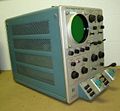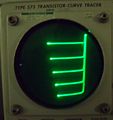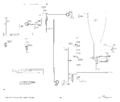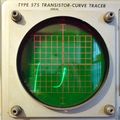575: Difference between revisions
No edit summary |
|||
| Line 55: | Line 55: | ||
File:Tek 575 8250.JPG | File:Tek 575 8250.JPG | ||
</gallery> | </gallery> | ||
[[Category:Curve tracers]] | |||
[[Category:Specifications needed]] | |||
Revision as of 07:26, 9 May 2014
The Tektronix 575 is a curve tracer for transistors, introduced in March 1957. It can be thought of as being composed of three modules: an x-y display, a step source, and a collector sweep source.
X-Y display
The vertical and horizontal amplifiers are very similar, using the two halves of a 6CG7 dual-triode tube as the output amplifier. The CRT has -1700V on the cathode and +2500V on the anode. The HV power supply uses two 5642 rectifier tubes.
Step Source
This uses a gated miller integrator to generate controlled steps. The result is a staircase waveform, which generates different traces in the the family of I-V curves of the transistor.
Collector Sweep
Power from the mains goes through an isolation transformer and a variac and is rectified by germanium diodes to produce the collector sweep voltage. The isolation transformer has two pairs of secondary taps, one for high voltage (0 to 200V) and low current, the other for low voltage (0 to 20V) and high current. The maximum power that can be delivered to the transistor in either mode is approximately 200 watts.
575 with Mod122c has extended collector sweep voltage to 400V.
Type 175 High Current Adaptor
The 575 can be paired with a 175 for high current device measurements.
-
575 on 175
It is possible to use the 575 as an X-Y monitor. The vertical and horizontal range switches have settings for external input, at 0.1 V/div sensitivity.
Rectifiers
Early 575 versions used selenium rectifiers. A kit for conversion to silicon diodes was available and is documented in the back of the manual.
The 575 has a thermal cutoff.
- Tektronix 575 and 175 Manual (PDF)
- Tektronix 575 with Mod 122C Manual (PDF)
- "A Power Curve Tracer At Surplus Prices" by Dennis L. Feucht (PDF)
- Some Transistor Measurements Using the Type 575
- Tektronix 575 Factory Calibration Procedure (PDF)
- 013-0069-00 3-Terminal Adapter (PDF)
-
575 w/o Mod 122C
-
575 w Mod 122C
-
-
-
-
-
Unmodified Collector Supply
-
Collector Supply Rectifier with MOD122C
-
Main Power Supply
-
Step Generator
-
Amplifiers
-
CRT Circuit
-
575 testing a tunnel diode
-














